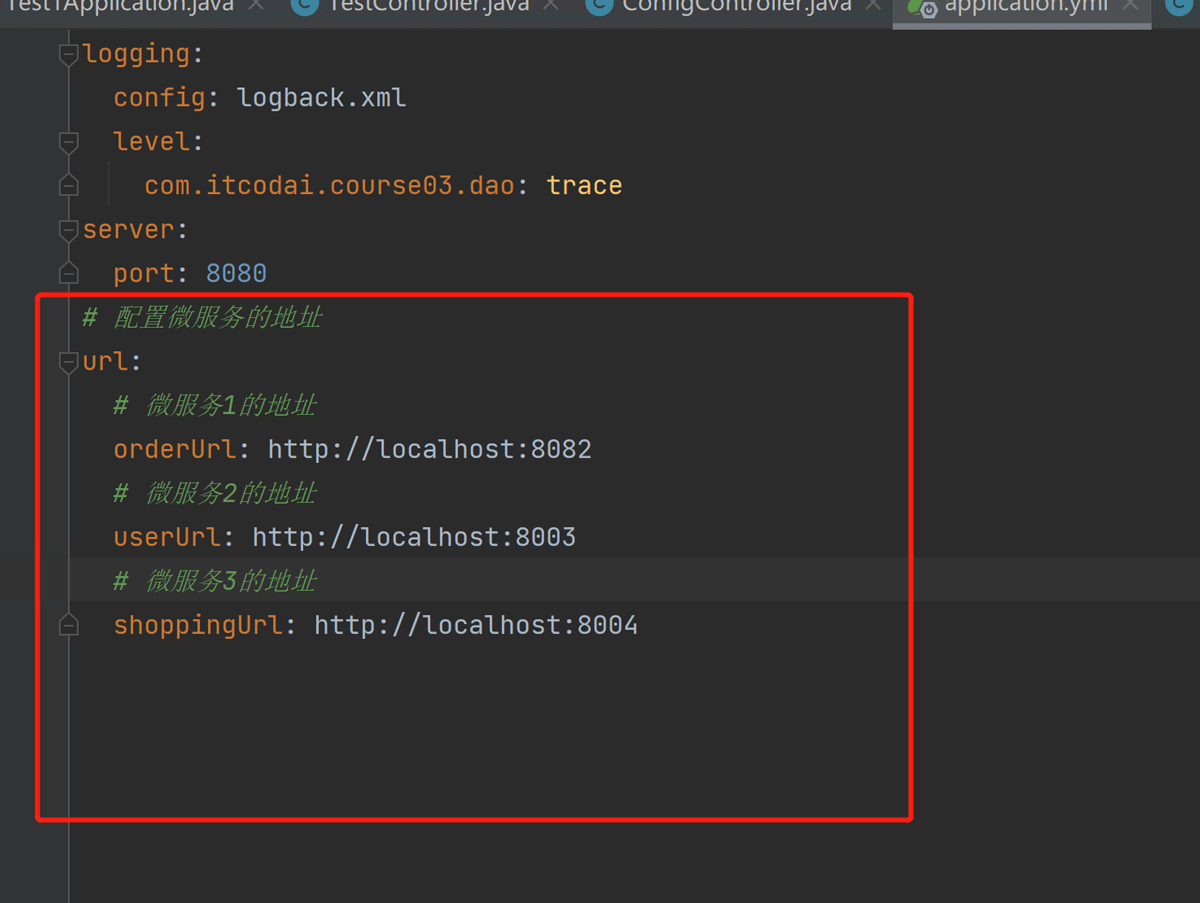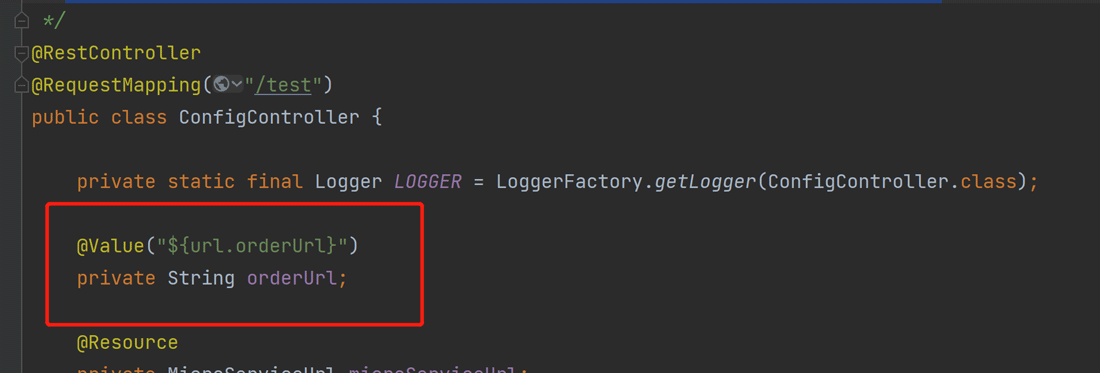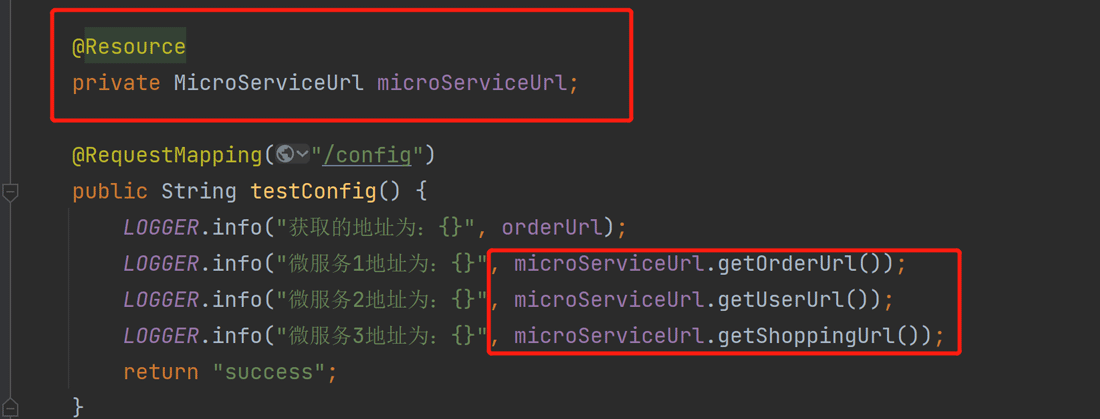Comment obtenir la valeur dans application.yml au Springboot
Dans les projets, certaines informations de configuration sont souvent nécessaires. Ces informations peuvent avoir des configurations différentes dans l'environnement de test et dans l'environnement de production, et peuvent devoir être modifiées ultérieurement en fonction des conditions commerciales réelles. Nous ne pouvons pas coder en dur ces configurations dans le code. Il est préférable de les écrire dans le fichier de configuration. Par exemple, vous pouvez écrire ces informations dans le fichier application.yml . application.yml 文件中。

那么,怎么在代码里获取或者使用这个地址呢?有2个方法。
方法一:
我们可以通过@Value 注解的 ${key} 即可获取配置文件(application.yml)中和 key 对应的 value 值,这个方法适用于微服务比较少的情形

方法二:
在实际项目中,遇到业务繁琐,逻辑复杂的情况,需要考虑封装一个或多个配置类。比如,如果一个业务需要同时使用微服务1、微服务2和微服务3,那么这些微服务将被调用。
如果这样一个个去使用 @Value 注解引入相应的微服务地址的话,太过于繁琐。
也许实际业务中,远远不止这三个微服务,甚至十几个都有可能。对于这种情况,我们可以先定义一个 MicroServiceUrl

Donc , comment ? Comment obtenir ou utiliser cette adresse en code ? Il existe 2 méthodes.
Méthode 1 :
Nous pouvons obtenir la valeur correspondant à la clé dans le fichier de configuration (application.yml) grâce au ${key} annoté avec @Value. Cette méthode convient à ceux qui en ont relativement peu. microservices. Situation
Méthode 2 :
 Dans les projets réels, lorsque vous rencontrez des affaires complexes et une logique complexe, vous devez envisager d'encapsuler une ou plusieurs classes de configuration. Par exemple, si une entreprise doit utiliser simultanément le microservice 1, le microservice 2 et le microservice 3, alors ces microservices seront appelés. 🎜Il serait trop fastidieux d'utiliser l'annotation @Value pour introduire une à une les adresses de microservices correspondantes. 🎜🎜Peut-être que dans les affaires réelles, il existe bien plus que ces trois microservices, voire plus d'une douzaine. Pour cette situation, nous pouvons d'abord définir une classe
Dans les projets réels, lorsque vous rencontrez des affaires complexes et une logique complexe, vous devez envisager d'encapsuler une ou plusieurs classes de configuration. Par exemple, si une entreprise doit utiliser simultanément le microservice 1, le microservice 2 et le microservice 3, alors ces microservices seront appelés. 🎜Il serait trop fastidieux d'utiliser l'annotation @Value pour introduire une à une les adresses de microservices correspondantes. 🎜🎜Peut-être que dans les affaires réelles, il existe bien plus que ces trois microservices, voire plus d'une douzaine. Pour cette situation, nous pouvons d'abord définir une classe MicroServiceUrl pour enregistrer spécifiquement l'URL du microservice🎜import org.springframework.boot.context.properties.ConfigurationProperties;
import org.springframework.stereotype.Component;
@Component
@ConfigurationProperties(prefix = "url")
public class MicroServiceUrl {
private String orderUrl;
private String userUrl;
private String shoppingUrl;
public String getOrderUrl() {
return orderUrl;
}
public void setOrderUrl(String orderUrl) {
this.orderUrl = orderUrl;
}
public String getUserUrl() {
return userUrl;
}
public void setUserUrl(String userUrl) {
this.userUrl = userUrl;
}
public String getShoppingUrl() {
return shoppingUrl;
}
public void setShoppingUrl(String shoppingUrl) {
this.shoppingUrl = shoppingUrl;
}
}<dependency> <groupId>org.springframework.boot</groupId> <artifactId>spring-boot-configuration-processor</artifactId> <optional>true</optional> </dependency>
import com.example.test1.config.MicroServiceUrl;
import org.slf4j.Logger;
import org.slf4j.LoggerFactory;
import org.springframework.beans.factory.annotation.Value;
import org.springframework.web.bind.annotation.RequestMapping;
import org.springframework.web.bind.annotation.RestController;
import javax.annotation.Resource;
/**
* 获取配置文件(application.yml)中和 key 对应的 value 值
* 2种方法
*/
@RestController
@RequestMapping("/test")
public class ConfigController {
private static final Logger LOGGER = LoggerFactory.getLogger(ConfigController.class);
@Value("${url.orderUrl}")
private String orderUrl;
@Resource
private MicroServiceUrl microServiceUrl;
@RequestMapping("/config")
public String testConfig() {
LOGGER.info("获取的地址为:{}", orderUrl);
LOGGER.info("微服务1地址为:{}", microServiceUrl.getOrderUrl());
LOGGER.info("微服务2地址为:{}", microServiceUrl.getUserUrl());
LOGGER.info("微服务3地址为:{}", microServiceUrl.getShoppingUrl());
return "success";
}
}Ce qui précède est le contenu détaillé de. pour plus d'informations, suivez d'autres articles connexes sur le site Web de PHP en chinois!

Outils d'IA chauds

Undresser.AI Undress
Application basée sur l'IA pour créer des photos de nu réalistes

AI Clothes Remover
Outil d'IA en ligne pour supprimer les vêtements des photos.

Undress AI Tool
Images de déshabillage gratuites

Clothoff.io
Dissolvant de vêtements AI

AI Hentai Generator
Générez AI Hentai gratuitement.

Article chaud

Outils chauds

Bloc-notes++7.3.1
Éditeur de code facile à utiliser et gratuit

SublimeText3 version chinoise
Version chinoise, très simple à utiliser

Envoyer Studio 13.0.1
Puissant environnement de développement intégré PHP

Dreamweaver CS6
Outils de développement Web visuel

SublimeText3 version Mac
Logiciel d'édition de code au niveau de Dieu (SublimeText3)
 Comment Springboot intègre Jasypt pour implémenter le chiffrement des fichiers de configuration
Jun 01, 2023 am 08:55 AM
Comment Springboot intègre Jasypt pour implémenter le chiffrement des fichiers de configuration
Jun 01, 2023 am 08:55 AM
Introduction à Jasypt Jasypt est une bibliothèque Java qui permet à un développeur d'ajouter des fonctionnalités de chiffrement de base à son projet avec un minimum d'effort et ne nécessite pas une compréhension approfondie du fonctionnement du chiffrement. Haute sécurité pour le chiffrement unidirectionnel et bidirectionnel. technologie de cryptage basée sur des normes. Cryptez les mots de passe, le texte, les chiffres, les binaires... Convient pour l'intégration dans des applications basées sur Spring, API ouverte, pour une utilisation avec n'importe quel fournisseur JCE... Ajoutez la dépendance suivante : com.github.ulisesbocchiojasypt-spring-boot-starter2 1.1. Les avantages de Jasypt protègent la sécurité de notre système. Même en cas de fuite du code, la source de données peut être garantie.
 Comment SpringBoot intègre Redisson pour implémenter la file d'attente différée
May 30, 2023 pm 02:40 PM
Comment SpringBoot intègre Redisson pour implémenter la file d'attente différée
May 30, 2023 pm 02:40 PM
Scénario d'utilisation 1. La commande a été passée avec succès mais le paiement n'a pas été effectué dans les 30 minutes. Le paiement a expiré et la commande a été automatiquement annulée 2. La commande a été signée et aucune évaluation n'a été effectuée pendant 7 jours après la signature. Si la commande expire et n'est pas évaluée, le système donne par défaut une note positive. 3. La commande est passée avec succès. Si le commerçant ne reçoit pas la commande pendant 5 minutes, la commande est annulée. 4. Le délai de livraison expire et. un rappel par SMS est envoyé... Pour les scénarios avec des délais longs et de faibles performances en temps réel, nous pouvons utiliser la planification des tâches pour effectuer un traitement d'interrogation régulier. Par exemple : xxl-job Aujourd'hui, nous allons choisir
 Comment utiliser Redis pour implémenter des verrous distribués dans SpringBoot
Jun 03, 2023 am 08:16 AM
Comment utiliser Redis pour implémenter des verrous distribués dans SpringBoot
Jun 03, 2023 am 08:16 AM
1. Redis implémente le principe du verrouillage distribué et pourquoi les verrous distribués sont nécessaires. Avant de parler de verrous distribués, il est nécessaire d'expliquer pourquoi les verrous distribués sont nécessaires. Le contraire des verrous distribués est le verrouillage autonome. Lorsque nous écrivons des programmes multithreads, nous évitons les problèmes de données causés par l'utilisation d'une variable partagée en même temps. Nous utilisons généralement un verrou pour exclure mutuellement les variables partagées afin de garantir l'exactitude de celles-ci. les variables partagées. Son champ d’utilisation est dans le même processus. S’il existe plusieurs processus qui doivent exploiter une ressource partagée en même temps, comment peuvent-ils s’exclure mutuellement ? Les applications métier d'aujourd'hui sont généralement une architecture de microservices, ce qui signifie également qu'une application déploiera plusieurs processus si plusieurs processus doivent modifier la même ligne d'enregistrements dans MySQL, afin d'éviter les données sales causées par des opérations dans le désordre, les besoins de distribution. à introduire à ce moment-là. Le style est verrouillé. Vous voulez marquer des points
 Comment résoudre le problème selon lequel Springboot ne peut pas accéder au fichier après l'avoir lu dans un package jar
Jun 03, 2023 pm 04:38 PM
Comment résoudre le problème selon lequel Springboot ne peut pas accéder au fichier après l'avoir lu dans un package jar
Jun 03, 2023 pm 04:38 PM
Springboot lit le fichier, mais ne peut pas accéder au dernier développement après l'avoir empaqueté dans un package jar. Il existe une situation dans laquelle Springboot ne peut pas lire le fichier après l'avoir empaqueté dans un package jar. La raison en est qu'après l'empaquetage, le chemin virtuel du fichier. n’est pas valide et n’est accessible que via le flux Read. Le fichier se trouve sous les ressources publicvoidtest(){Listnames=newArrayList();InputStreamReaderread=null;try{ClassPathResourceresource=newClassPathResource("name.txt");Input
 Comment implémenter Springboot+Mybatis-plus sans utiliser d'instructions SQL pour ajouter plusieurs tables
Jun 02, 2023 am 11:07 AM
Comment implémenter Springboot+Mybatis-plus sans utiliser d'instructions SQL pour ajouter plusieurs tables
Jun 02, 2023 am 11:07 AM
Lorsque Springboot+Mybatis-plus n'utilise pas d'instructions SQL pour effectuer des opérations d'ajout de plusieurs tables, les problèmes que j'ai rencontrés sont décomposés en simulant la réflexion dans l'environnement de test : Créez un objet BrandDTO avec des paramètres pour simuler le passage des paramètres en arrière-plan. qu'il est extrêmement difficile d'effectuer des opérations multi-tables dans Mybatis-plus. Si vous n'utilisez pas d'outils tels que Mybatis-plus-join, vous pouvez uniquement configurer le fichier Mapper.xml correspondant et configurer le ResultMap malodorant et long, puis. écrivez l'instruction SQL correspondante Bien que cette méthode semble lourde, elle est très flexible et nous permet de
 Comparaison et analyse des différences entre SpringBoot et SpringMVC
Dec 29, 2023 am 11:02 AM
Comparaison et analyse des différences entre SpringBoot et SpringMVC
Dec 29, 2023 am 11:02 AM
SpringBoot et SpringMVC sont tous deux des frameworks couramment utilisés dans le développement Java, mais il existe des différences évidentes entre eux. Cet article explorera les fonctionnalités et les utilisations de ces deux frameworks et comparera leurs différences. Tout d’abord, découvrons SpringBoot. SpringBoot a été développé par l'équipe Pivotal pour simplifier la création et le déploiement d'applications basées sur le framework Spring. Il fournit un moyen rapide et léger de créer des fichiers exécutables autonomes.
 Comment SpringBoot personnalise Redis pour implémenter la sérialisation du cache
Jun 03, 2023 am 11:32 AM
Comment SpringBoot personnalise Redis pour implémenter la sérialisation du cache
Jun 03, 2023 am 11:32 AM
1. Personnalisez RedisTemplate1.1, mécanisme de sérialisation par défaut RedisAPI. L'implémentation du cache Redis basée sur l'API utilise le modèle RedisTemplate pour les opérations de mise en cache des données. Ici, ouvrez la classe RedisTemplate et affichez les informations sur le code source de la classe. Déclarer la clé, diverses méthodes de sérialisation de la valeur, la valeur initiale est vide @NullableprivateRedisSe
 Comment obtenir la valeur dans application.yml au Springboot
Jun 03, 2023 pm 06:43 PM
Comment obtenir la valeur dans application.yml au Springboot
Jun 03, 2023 pm 06:43 PM
Dans les projets, certaines informations de configuration sont souvent nécessaires. Ces informations peuvent avoir des configurations différentes dans l'environnement de test et dans l'environnement de production, et peuvent devoir être modifiées ultérieurement en fonction des conditions commerciales réelles. Nous ne pouvons pas coder en dur ces configurations dans le code. Il est préférable de les écrire dans le fichier de configuration. Par exemple, vous pouvez écrire ces informations dans le fichier application.yml. Alors, comment obtenir ou utiliser cette adresse dans le code ? Il existe 2 méthodes. Méthode 1 : Nous pouvons obtenir la valeur correspondant à la clé dans le fichier de configuration (application.yml) via le ${key} annoté avec @Value. Cette méthode convient aux situations où il y a relativement peu de microservices. Méthode 2 : En réalité. projets, Quand les affaires sont compliquées, la logique






